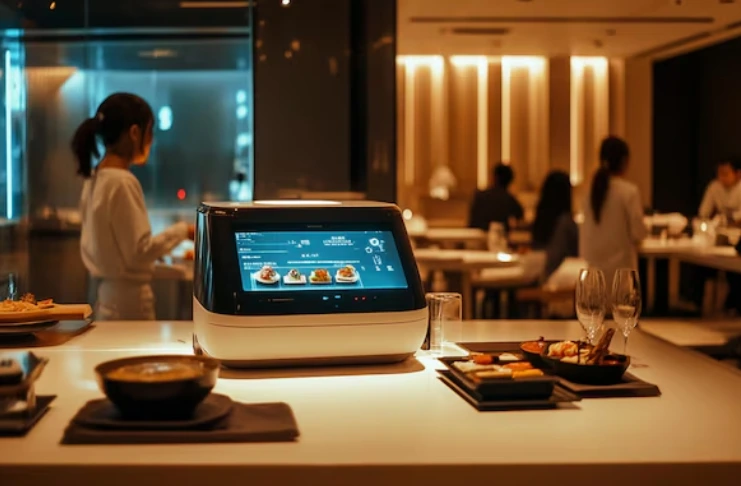How Technology is Revolutionizing Service Quality in Casual Dining by Lawrence Todd Maxwell of MX Properties, Inc

Technology continues to redefine customer experiences across industries—and casual dining restaurants are no exception. From streamlining order processes to improving kitchen workflows, the service industry has embraced digital innovations to enhance efficiency and elevate service quality. But how exactly does technology improve casual dining experiences? If you’re in the service industry or a tech enthusiast eager to learn more, keep reading.
This blog outlines how technology is reshaping casual dining by simplifying operations, personalizing customer experiences, and boosting staff productivity. We’ll also explore how these changes are influencing the perception of casual dining within the competitive retail and real estate landscape, including Orlando commercial real estate and Vero Beach commercial real estate.
Enhanced Order Taking & Payment ProcessesDigital Menus and Ordering Systems
Gone are the days of paper menus and error-prone verbal orders. Many casual dining restaurants now use digital tablets or kiosks at tables, enabling customers to browse menus, customize their meals, and place orders directly. These systems reduce miscommunication between customers and servers, ensuring orders are accurate and timely.
For example, restaurant chains like Panera Bread use touchscreen ordering stations and mobile apps to create a seamless ordering experience. Customers save time, and staff are freed up to focus on other high-value tasks like table service.
Contactless Payments
The emergence of contactless payment options, such as mobile wallets, QR codes, and Near Field Communication (NFC) technology, has made transactions faster and safer. These systems save customers from fumbling for cash or cards while minimizing contact—a priority that gained prominence during the COVID-19 pandemic.
Restaurants integrating these advancements report higher customer satisfaction scores and a boost in table turnover rates. Faster transactions not only enhance customer experiences but also help casual dining restaurants fit more patrons into their operational hours.
Improved Kitchen Efficiency & Food QualitySmart Kitchen Equipment
Technology-driven kitchen equipment is no longer an investment reserved for fine-dining establishments. Today, casual dining players are optimizing food preparation with smart ovens, fryers, and refrigerators that can monitor and adjust cooking parameters automatically. These appliances ensure consistency, reduce food waste, and save time.
For instance, some restaurants use devices that can determine the ideal cooking time and temperature for each dish, automating precision and reducing room for error. This translates into food that’s consistently fresh and delicious.
Kitchen Display Systems (KDS)
The days of handwritten order slips in the kitchen are over. Instead, many casual dining restaurants now employ Kitchen Display Systems to streamline ticket organization. These systems display orders digitally, sorting them by priority and tracking preparation times. Staff can immediately see cooking instructions, making the process efficient.
Popular enterprises in Vero Beach commercial real estate often link their dining establishments with cloud-based KDS systems, ensuring centralized management of operations across multiple key locations.
Personalized Customer Experience through Data AnalyticsCustomer Insights for Tailored Experiences
Big data and analytics empower casual dining restaurants to better understand their customer preferences. Every interaction through loyalty programs, reservation platforms, or apps provides valuable insights into dining habits, favorite dishes, and spending patterns.
For example, imagine a smartphone app that recognizes customers based on previous orders and suggests menu items they might enjoy. This kind of personalization encourages repeat visits and builds long-term customer loyalty.
Customer Relationship Management (CRM)
Many casual dining restaurants also rely on CRM software to maintain detailed customer profiles. This software can help track birthdays, dining anniversaries, or dietary restrictions, allowing staff to go the extra mile. A simple gesture like offering a personalized discount for a repeat customer’s anniversary can create memorable dining experiences.
Such data-driven personalization is extremely potent in highly competitive markets like Orlando commercial real estate, where casual dining businesses continuously compete to create richer brand value and customer experiences.
Streamlined Staff Management & CommunicationWorkforce Scheduling Tools
Efficient staff management is critical to running a successful casual dining restaurant. Workforce scheduling tools use AI and predictive analytics to optimize staff schedules based on expected foot traffic, peak hours, and even weather patterns. This ensures restaurants have the right number of employees on duty to meet demand without overstaffing.
Communication Apps for Teams
Modern technology also addresses communication challenges among restaurant staff. Platforms like Slack or proprietary apps enable instantaneous communication between kitchen staff, servers, and management. This creates a streamlined flow of information regarding orders, special requests, or inventory alerts.
The impact of such innovations resonates strongly in areas like retail real estate and casual dining restaurants tied to Orlando commercial real estate. Here, effective team management is essential not just for delivering exceptional dining experiences but also for maintaining operational margins in high-rent locations.
Why Technology Is the Future of Casual Dining Success & Retail Real Estate in Florida
For casual dining restaurants, integrating the right technologies isn’t just a matter of convenience—it’s a strategy for long-term success. From smarter kitchens to personalized customer experiences powered by data insights, businesses leveraging these advancements are positioning themselves at the forefront of innovation.
Whether you’re investing in casual dining within competitive markets like Vero Beach retail real estate or exploring dining as part of the larger Orlando commercial real estate scene, adopting technology is essential to standing out and meeting modern customer expectations.
Are you ready to explore how technology can elevate your casual dining restaurant? Start implementing these tech-driven strategies today to streamline operations, improve customer experiences, and drive your business toward success.




